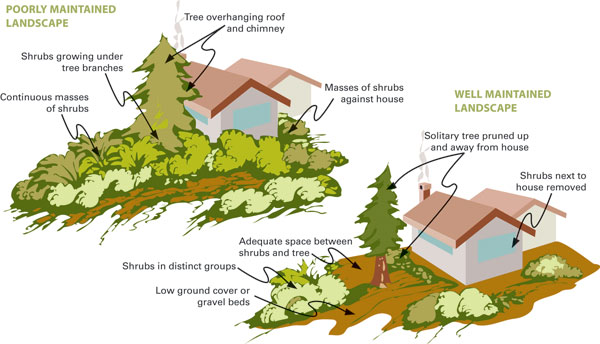Firewise Landscaping: The Basics
by Michael Kuhns, Extension Forestry Specialist
Throughout the West, and in much of the rest of the country, fires in the wildland/urban interface are becoming more common as people choose to live in previously undeveloped areas on the edges of cities. The vegetation in these areas usually consists of trees, shrubs, and grasses that often are very flammable. Fire is often a natural, integral part of the landscape in these interface areas. But when people move-in and build homes, a minor fire that might burn a few trees and shrubs can become a major disaster.
If people are going to live in fire-prone areas, it is the responsibility of those people and their communities to reduce the risk of fire. Building design and materials, landscape design and maintenance, firefighting infrastructure (roads, equipment, water supply), and accessibility all affect this risk. The rest of this article will discuss the role of landscape design and maintenance, or firewise landscaping, in reducing fire risk in the wildland/urban interface.

A landscape that gives a building the best chance for surviving a wildfire is one that provides a defensible space. Fires need fuel, oxygen, and heat to burn. Defensible space landscapes are low in fuel, keeping the fire far enough away that firefighters have a chance to defend the building. To construct a defensible space:
- Cut tall grass near structures. A fire in dry grass burns quickly and is very difficult to control.
- Remove excess brush and small trees from at least 30 feet around buildings. Dense brush burns quickly and can provide a "ladder" for low flames to reach up into larger trees. Widely spaced trees and shrubs can be left in the landscape for shade and esthetics.
- On larger lots, maintain a fuel break of low-growing plants 30 to 70 feet out from buildings. Such fuel breaks act as a buffer between the manicured landscape near the home and the adjacent wildlands. Two homes - one with poor landscaping choices and one with good landscaping choices
- Rake up leaves and twigs. Remove plant litter (dead leaves, twigs, etc.) that accumulates under trees and shrubs to reduce fuel loads. Tree litter that accumulates on roofs and in gutters should also be removed regularly. Large amounts of litter can accumulate on lower branches of trees and shrubs and should be removed. Removal of heavy litter accumulations in adjacent wildland areas also should be done if possible. Removed litter should be placed in an approved landfill. It should not be piled on the property or in adjacent woodlands.
- Prune tree branches. Prune branches up to ten to twenty feet above the ground on large trees to prevent low fires from reaching the tree crowns.
- Thin dense tree groups. Though the grouping of trees is normally a good landscaping technique, in fire-prone areas it can be hazardous. Thinning these groups will slow the spread of fire.
- Remove firewood and other combustible materials from around buildings. Firewood should be stored on the outside edge of your defensible space.
- Make sure firefighters can reach all parts of your property. Place fences, trees, retaining walls, etc. so that they don't restrict firefighting equipment access.
- Choose landscape plants that are less flammable. All plants will burn if a fire is severe enough. Some plants are more fire-prone than others, however. Conifers such as pines and spruces tend to be fairly flammable, while many broadleaved trees are fairly fire resistant.
- Cooperate with neighbors to provide large defensible spaces. A thirty foot wide clear space around a home may not be adequate in a severe fire, especially if neighboring properties have not been well-designed or maintained. Neighbors should cooperate to reduce fire risk by having good defensible spaces that join one another.
- Check your landscape monthly. Maintenance is a never-ending task. Inspect landscapes monthly and attend to problem situations before they become serious hazards.
Though a thirty foot wide defensible space around a home is generally adequate, maintain the additional fuel break at 30 to 70 feet if possible. This becomes especially important when local conditions may cause especially severe fires. Houses located high on steep slopes will need wider clear spaces to protect from fires burning up-hill. Local wind conditions may also warrant wider cleared areas.
These techniques will not guarantee complete fire safety. However, firewise landscaping can greatly increase a home's chances of survival if a fire occurs.

